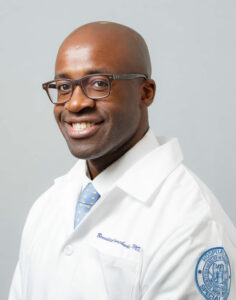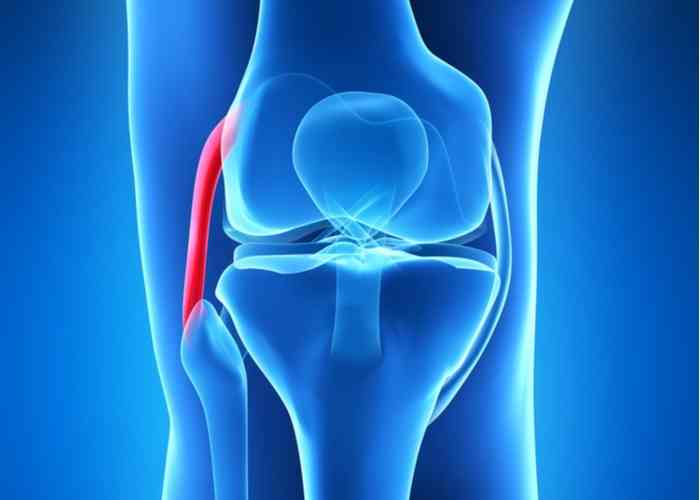LCL/FCL Surgeon

LCL and FCL injuries usually occur from trauma, due to a great amount of force applied to the inner part of the knee. If the LCL is stretched or torn, an LCL or FCL reconstruction may be needed to restore knee stability. LCL/FCL reconstruction surgeon, Doctor Benedict Nwachukwu provides diagnosis as well as surgical and nonsurgical treatment options for patients in Manhattan, New York City, NY who have sustained an LCL/FCL injury. Contact Dr. Nwachukwu’s team today!
What is the LCL or FCL?
The lateral or fibular collateral ligament, LCL/FCL is a cord-like band of tissue that acts as the primary varus stabilizer of the knee joint. The LCL is one of the four critical ligaments within the knee that are responsible for stabilization. The LCL is sometimes called the FCL because it connects to the fibula (small lower leg bone). The connection point from the femur (thigh bone) to the tibia is important in keeping the knee from collapsing to the medial side when force is applied to the knee. LCL or FCL injuries usually occur from trauma, due to a great amount of force applied to the inner part of the knee. If the LCL is stretched or torn, an LCL or FCL Reconstruction may be needed to restore knee stability. Dr. Benedict Nwachukwu, complex knee surgeon serving patients in Manhattan, New York City and the surrounding New York boroughs, can diagnose and treat patients who have torn their LCL or who have an FCL injury.

What is a lateral collateral ligament (LCL) reconstruction?
Lateral collateral ligament reconstruction is an open procedure and cannot be done arthroscopically. During this specialized procedure, Dr. Nwachukwu will replace the torn lateral collateral ligament with a tissue graft. The graft is either obtained from the patient (autograft) or from a donor tissue bank (allograft). The goal of an LCL reconstruction is to match the anatomical footprint of the original ligament to restore full lateral collateral ligament function, stability and flexibility.
Who should have LCL or FCL reconstruction?
The lateral collateral ligament does not heal as well as other ligaments in the knee. Reconstruction is recommended for the following LCL injuries:
- Grade 3 tears
- Knee instability
- Non-surgical techniques have failed to alleviate symptoms
- LCL tears that occur with other knee ligament damage
How is LCL reconstruction surgery performed?
An LCL or FCL reconstruction is a complex knee surgery and should only be performed by an experienced surgeon like Dr. Benedict Nwachukwu. The placement of the graft is critical to the long-term health of the knee, as well as the post-surgical protocol.
During this complex knee surgery, Dr. Nwachukwu will first obtain and prepare the tissue graft. An autograft is often obtained from the patient’s hamstring tendon, or a donor graft can be used. Utilizing the open incision allows Dr. Nwachukwu to visualize the knee joint. He then drills small precise holes in both the femur and the fibula, forming tunnels. The ends of the tendon graft are threaded through the tunnels and are fixed in place with either metal staples, large sutures or surgical screws. Dr. Nwachukwu will check to make sure the tendon is tight and properly secured so it can perform like the original ligament.
What happens after LCL reconstruction?
Patients in New York who undergo LCL reconstruction can expect the following after surgery:
- A brace is placed immediately following surgery to protect the joint and to allow the graft to heal. Bracing is often recommended for 6 to 8 weeks.
- Patients will be non-weight bearing for approximately 6 weeks.
- Ice, elevation and rest can help with post-surgical pain.
- Pain medication will be prescribed to be taken as directed.
- Early knee motion, usually using a passive motion device should begin immediately and continue for 2 weeks.
- Avoid active hamstring exercises or strengthening exercises for the first 4 months.
- Use of a stationary bike may begin around 6 weeks post-surgery.
How long is the recovery after LCL reconstruction?
A new, reconstructed LCL takes time to heal and to attach to the bone. It is important for patients in New York to follow Dr. Nwachukwu’s recovery protocol and to take care not to rush their healing ligament. Patients without underlying health issues can expect the following general timelines:
- Passive knee exercises for 6 weeks.
- Non-weight bearing for 6 to 8 weeks.
- Active knee motion after 6 weeks.
- Stationary bike exercises after 6 weeks.
- Return to regular activities after 5 to 6 months.
- Return to sporting activities in about 6 to 9 months.
- A secure brace is recommended during sporting activities to protect the healing graft for up to 9 months after surgery.
For more information on LCL or FLC reconstruction or on how the lateral collateral ligament is reconstructed in the knee, please contact the office of Benedict Nwachukwu, MD, orthopedic knee surgeon serving Manhattan, New York City and the surrounding New York boroughs.





